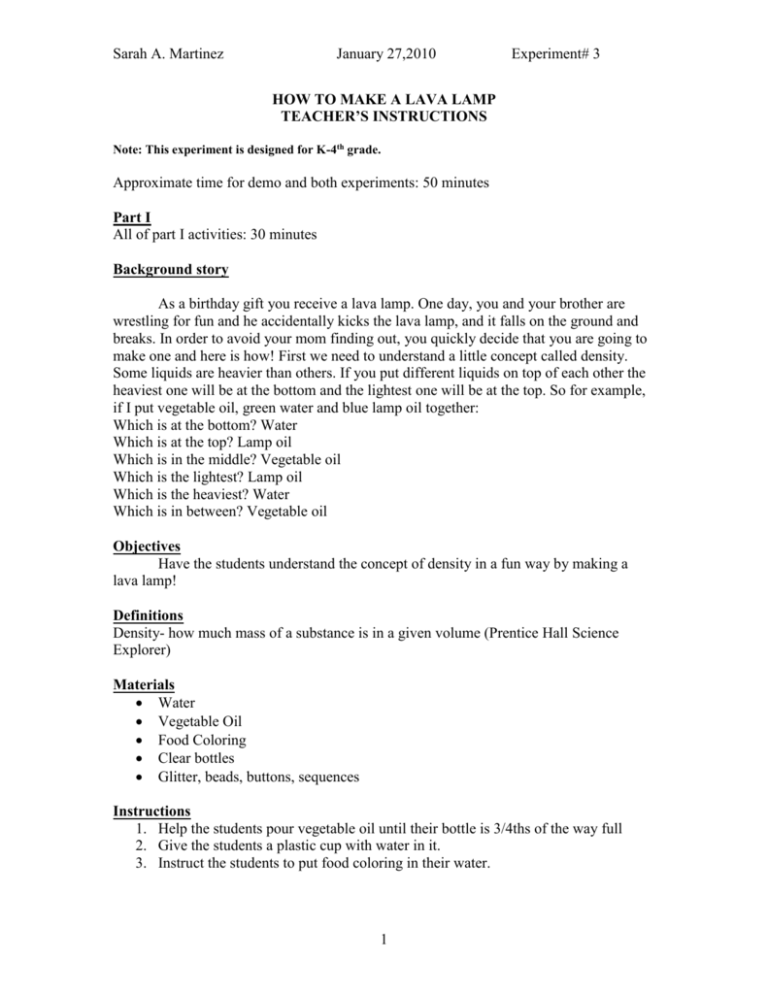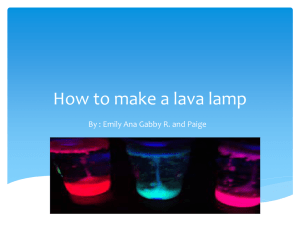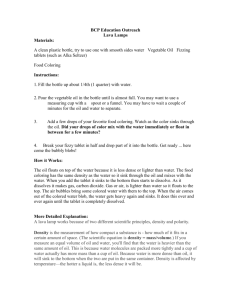
Sarah A. Martinez
January 27,2010
Experiment# 3
HOW TO MAKE A LAVA LAMP
TEACHER’S INSTRUCTIONS
Note: This experiment is designed for K-4th grade.
Approximate time for demo and both experiments: 50 minutes
Part I
All of part I activities: 30 minutes
Background story
As a birthday gift you receive a lava lamp. One day, you and your brother are
wrestling for fun and he accidentally kicks the lava lamp, and it falls on the ground and
breaks. In order to avoid your mom finding out, you quickly decide that you are going to
make one and here is how! First we need to understand a little concept called density.
Some liquids are heavier than others. If you put different liquids on top of each other the
heaviest one will be at the bottom and the lightest one will be at the top. So for example,
if I put vegetable oil, green water and blue lamp oil together:
Which is at the bottom? Water
Which is at the top? Lamp oil
Which is in the middle? Vegetable oil
Which is the lightest? Lamp oil
Which is the heaviest? Water
Which is in between? Vegetable oil
Objectives
Have the students understand the concept of density in a fun way by making a
lava lamp!
Definitions
Density- how much mass of a substance is in a given volume (Prentice Hall Science
Explorer)
Materials
Water
Vegetable Oil
Food Coloring
Clear bottles
Glitter, beads, buttons, sequences
Instructions
1. Help the students pour vegetable oil until their bottle is 3/4ths of the way full
2. Give the students a plastic cup with water in it.
3. Instruct the students to put food coloring in their water.
1
Sarah A. Martinez
January 27,2010
Experiment# 3
4. Instruct the students to pour the water into the bottle with the vegetable oil. Make
sure to tell them to leave room in their bottle for any decorations.
5. Suggest to the students to add glitter, beads, buttons or sequences.
6. Also be sure to tape the top of the bottle to ensure that students do not open the
lava lamp and make a mess.
7. Have the students turn the bottle on its side and observe what it looks like.
Discussion Questions
When looking at the lava lamp you created, which is the heaviest liquid? Which is the
lightest liquid?
Congratulations class you have made a lava lamp to replace the one your brother broke!
Expected Results
The water and the oil will not mix due to the fact that water is heavier than oil. Water will
be the bottom layer and oil will be the top layer.
Reference
http://www.kids-science-experiments.com/makinglavalamp.html
Prentice Hall Science Explorer Chemical Building Blocks. Upper Saddle River: Pearson
Prentice Hall, 2004.
2
Sarah A. Martinez
January 27,2010
Experiment# 3
Part II
All of Part II activities: 20 minutes
HOW TO MAKE A CARDBOARD FISH SWIM?
Note: This experiment is designed for K- 4th grade.
Background story
You are an inventor and your boss tells you that he wants you to make a
cardboard fish swim in water and your job today is to figure out how.
Objectives
Have the students understand the concept of surface tension by making a
cardboard fish swim by releasing a non-polar substance: dish soap in a polar substance:
water.
Definitions
Surface tension- the inward pull of a liquid that bring the molecules at the surface closer
together making it act as though it has a skin (Prentice Hall Science Explorer)
An example of an organism that exhibits surface tension is a water strider. A water strider
gives an illusion of walking on water.
Polar- a molecule that has partially positive and partially negative charges
Non-polar- a molecule that only has one type of charge
Materials
Water
Pie pans for each student
Liquid dish soap
Cardboard cut out fish for each student
Instructions
1. Hand out a cardboard cut out fish and a pie pan to each child.
2. Have each color their fish with crayons.
3. Fill each child’s pie pan with water.
4. Place the fish gently on top of the water and place a tiny drop of dish soap behind
the fish and watch it swim away.
Expected Results
3
Sarah A. Martinez
January 27,2010
Experiment# 3
The fish will shoot forward once the soap is added because the soap breaks down
the surface tension between the water and the cardboard fish.
**Note- Soap cannot be added more than once because water will not react to the soap
again. Once the water is introduced to the non-polar substance: soap, the fish cannot be
shot forward again.
Experiment Variations
This experiment can also be done with matchsticks or any thing that will float on water.
Outside preparation
Cut out cardboard fish for each students
Bring at least 3 gallons of water and a bucket to throw waste away
Reference
http://www.kids-science-experiments.com/swimmingfish.html
Prentice Hall Science Explorer Chemical Building Blocks. Upper Saddle River: Pearson
Prentice Hall, 2004.
4
Sarah A. Martinez
January 27,2010
Experiment# 3
Experiment #3
STUDENT WORKSHEET
Name:
Date:
Part 1
Objectives
The goal of this experiment today is to understand the concept of density in a fun
way by making a lava lamp!
HOW TO MAKE A LAVA LAMP?
Step 1
Take your bottle
Step 2
Pour vegetable oil until your bottle is 3/4ths of the way full
Step 3
Put food coloring in their water that is in the cup
Step 4
Pour the water into the bottle with the vegetable oil. Make sure to leave room in their
bottle for any decorations.
Step 5
Add glitter, beads, buttons or sequences
5
Sarah A. Martinez
January 27,2010
Experiment# 3
Step 6
Add the cap onto your lava lamp
Step 7
Be sure to tape the top of the bottle.
Draw a picture of your lava lamp when the layers are completely separated.
Draw a picture of what your lava lamp looks like in motion.
6
Sarah A. Martinez
January 27,2010
Experiment# 3
Experiment #3
STUDENT WORKSHEET
Name:
Date:
Part 2
HOW TO MAKE A CARDBOARD FISH SWIM?
Step 1
Make sure your teacher gives you a cardboard cut out fish and a pie pan with water in it.
Step 2
Color only one side of your fish with crayons.
Step 3
Place the fish gently on top of the water and place a tiny drop of dish soap behind the fish
and watch it swim away.
Draw a picture of your fish
Congratulations you have made a cardboard fish swim in water!
7
Sarah A. Martinez
January 27,2010
8
Experiment# 3







